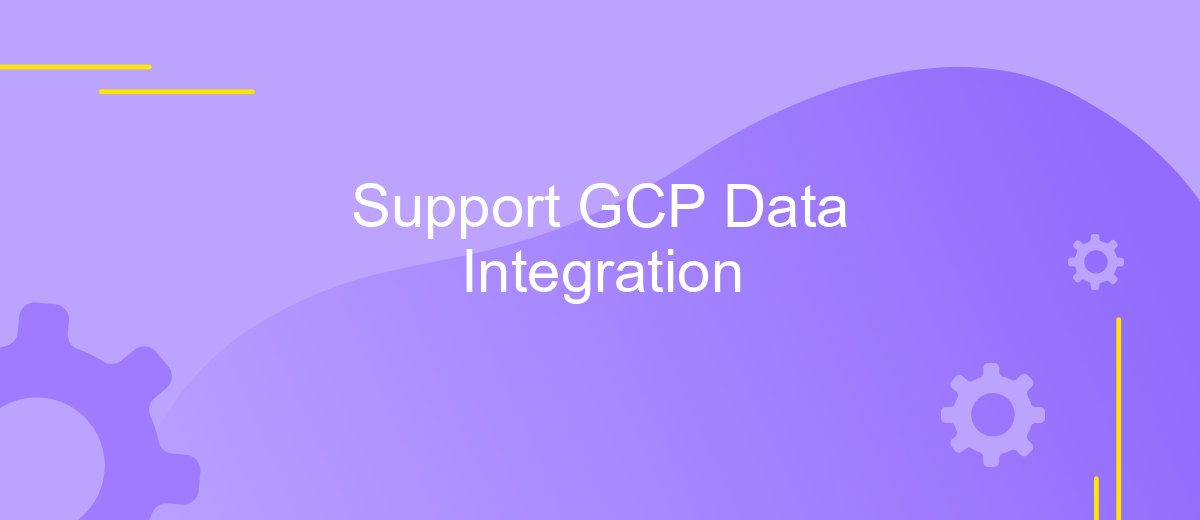Support GCP Data Integration
In today's data-driven world, seamless integration of data across platforms is crucial for informed decision-making. Google Cloud Platform (GCP) offers robust tools and services to facilitate efficient data integration, ensuring that businesses can harness the full potential of their data. This article explores the key features and benefits of GCP data integration, providing insights on how to optimize your data workflows.
Support Matrix
The Support Matrix for GCP Data Integration provides a comprehensive overview of the compatibility and support levels for various tools and services. This ensures seamless integration and efficient data management across different platforms and environments.
- Supported GCP Services: BigQuery, Cloud Storage, Pub/Sub, Dataflow
- Supported Data Sources: SQL, NoSQL, CSV, JSON
- Integration Tools: Apache Airflow, Talend, Informatica, Google Data Fusion
- Support Levels: Basic, Standard, Premium
- Operating Systems: Windows, Linux, macOS
By adhering to this Support Matrix, organizations can effectively plan and execute their data integration strategies. It helps in identifying the right tools and services that are compatible with their existing infrastructure, ensuring a smooth and efficient data integration process.
Supported Cloud Environments

Support for GCP data integration spans various cloud environments, ensuring seamless data flow and management across platforms. Google Cloud Platform (GCP) offers robust tools and services like BigQuery, Cloud Storage, and Dataflow, which are designed to handle complex data integration tasks. These tools enable users to efficiently manage, analyze, and visualize data across hybrid and multi-cloud environments, ensuring optimal performance and scalability.
Additionally, services like ApiX-Drive facilitate the integration process by providing automated workflows and real-time data synchronization between GCP and other cloud environments. ApiX-Drive simplifies the setup of data pipelines, reducing the need for manual intervention and minimizing errors. This service supports a wide range of applications and platforms, making it a versatile solution for businesses looking to streamline their data integration processes across different cloud infrastructures.
Contacting Google Cloud Support

If you encounter any issues or have questions regarding Google Cloud Platform (GCP) data integration, contacting Google Cloud Support can provide the assistance you need. Their support team is equipped with the expertise to handle a wide range of technical problems and inquiries, ensuring that your data integration processes run smoothly and efficiently.
- Visit the Google Cloud Support Center: Navigate to the official Google Cloud Support page to access various resources, including documentation, community forums, and support options.
- Choose a Support Plan: Depending on your needs, select an appropriate support plan. Options range from basic free support to premium offerings with enhanced response times and dedicated account managers.
- Submit a Support Request: Log in to your Google Cloud account and submit a support request. Provide detailed information about your issue to receive the most accurate and timely assistance.
- Utilize Community Resources: Engage with the Google Cloud Community for additional insights and solutions from other users and experts.
By following these steps, you can efficiently address any challenges you encounter with GCP data integration. Whether you need immediate help or long-term support, Google Cloud Support offers a variety of resources to meet your requirements and ensure the success of your projects.
Additional Resources

For those looking to deepen their understanding of GCP data integration, there are numerous resources available to help you get started. Whether you're a beginner or an experienced professional, these materials can provide valuable insights and practical knowledge.
First, consider exploring the official Google Cloud documentation. This comprehensive resource covers a wide range of topics, from basic concepts to advanced techniques, and includes tutorials, best practices, and troubleshooting guides.
- Google Cloud Documentation
- Google Cloud Training
- Google Cloud Blog
- Google Cloud Courses on Coursera
- Google Cloud YouTube Channel
Additionally, joining online communities and forums can be incredibly beneficial. Platforms like Stack Overflow, Reddit, and Google Cloud's own community forums offer a space to ask questions, share experiences, and connect with other professionals in the field. Engaging with these communities can provide real-world insights and solutions to common challenges.


Known Issues
While integrating GCP data, users may encounter several known issues that can hinder the process. One common problem is the misconfiguration of API permissions, which can lead to unauthorized access errors. Ensuring that all required APIs are enabled and that the service accounts have the correct permissions is crucial to avoid such issues. Another frequent issue is network latency, which can cause delays in data transfer and synchronization. Optimizing network settings and using efficient data transfer methods can help mitigate these delays.
Additionally, users often face challenges with data format compatibility when integrating GCP with other platforms. It's essential to ensure that the data formats are compatible or to use data transformation tools to convert the data into a suitable format. Services like ApiX-Drive can be particularly helpful in this regard, as they offer automated data integration and transformation solutions, simplifying the process and reducing the likelihood of errors. Lastly, monitoring and logging are critical for identifying and resolving issues promptly. Implementing robust monitoring tools can help track the integration process and quickly address any anomalies.
FAQ
How can I integrate my data from multiple sources into Google Cloud Platform (GCP)?
What are the common challenges in GCP data integration?
Can I automate data integration tasks on GCP?
How do I ensure data security during the integration process?
What are some best practices for managing data integration on GCP?
Time is the most valuable resource for business today. Almost half of it is wasted on routine tasks. Your employees are constantly forced to perform monotonous tasks that are difficult to classify as important and specialized. You can leave everything as it is by hiring additional employees, or you can automate most of the business processes using the ApiX-Drive online connector to get rid of unnecessary time and money expenses once and for all. The choice is yours!

